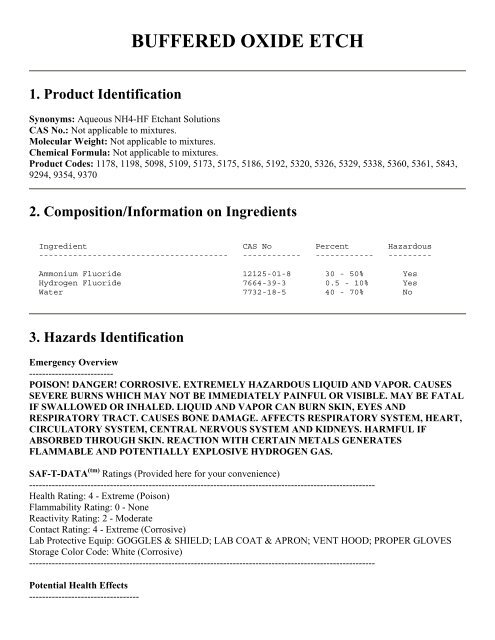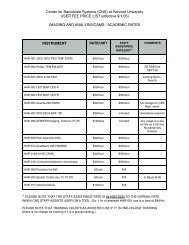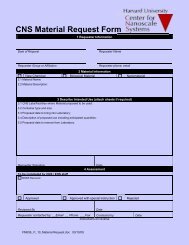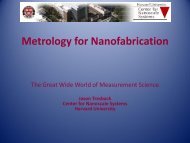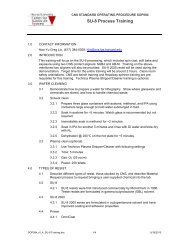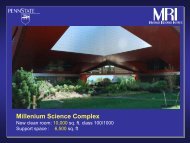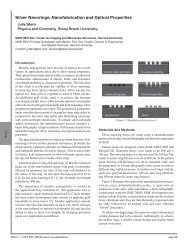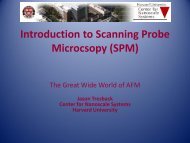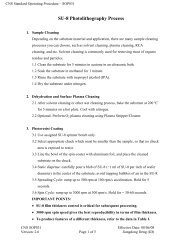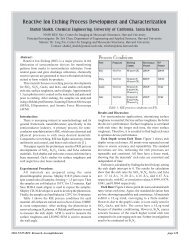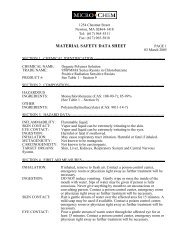BUFFERED OXIDE ETCH 5 to 1 - Center for Nanoscale Systems
BUFFERED OXIDE ETCH 5 to 1 - Center for Nanoscale Systems
BUFFERED OXIDE ETCH 5 to 1 - Center for Nanoscale Systems
- No tags were found...
You also want an ePaper? Increase the reach of your titles
YUMPU automatically turns print PDFs into web optimized ePapers that Google loves.
1) Irrigate eyes <strong>for</strong> at least 30 minutes with copious quantities of water, keeping the eyelids apart and away fromeyeballs during irrigation. 2) Get competent medical attention immediately, preferably an eye specialist. 3) If aphysician is not immediately available, apply one or two drops of ophthalmic anesthetic, (e.g., 0.5% Pon<strong>to</strong>caineHydrochloride solution). 4) Do not use oily drops, ointment or HF skin burn treatments. Place ice pack on eyesuntil reaching emergency room.Note <strong>to</strong> Physician:General: For burns of moderate areas, (greater than 8 square inches), ingestion and significant inhalationexposure, severe systemic effects may occur, and admission <strong>to</strong> a critical care unit should be considered. Moni<strong>to</strong>rand correct <strong>for</strong> hypocalcemia, cardiac arrhythmias, hypomagnesemia and hyperkalemia. In some cases renaldialysis may be indicated.Inhalation: Treat as chemical pneumonia. Moni<strong>to</strong>r <strong>for</strong> hypocalcemia, 2.5% calcium gluconate in normal salineby nebulizer or by IPPB with 100% oxygen may decrease pulmonary damage. Bronchodila<strong>to</strong>rs may also beadministered.Skin: For deep skin burns or contact with concentrated HF (over 50%) solution, consider infiltration about theaffected area with 5% calcium gluconate [equal parts of 10% calcium gluconate and sterile saline <strong>for</strong> injection].Burns beneath the nail may require splitting the nail and application of calcium gluconate <strong>to</strong> the exposed nailbed. For certain burns, especially of the digits, use of intra-arterial calcium gluconate may be indicated.Eyes: Irrigation may be facilitated by use of Morgan lens or similar ocular irriga<strong>to</strong>r, using 1% aqueous calciumgluconate solution [50ml of calcium gluconate 10% in 500 ml normal saline].AN ALTERNATIVE FIRST AID PROCEDURE: The effect of HF, i.e. onset of pain, particularly in dilutesolutions, may not be felt <strong>for</strong> up <strong>to</strong> 24 hours. It is important, there<strong>for</strong>e, that persons using HF have immediateaccess <strong>to</strong> an effective antidote even when they are away from their work place in order that first aid treatmentcan be commenced immediately.We recommend that any person in contact with HF should carry, or have access <strong>to</strong> a tube of HF Antidote Gel atall times; ideally with one tube at the work place, one on the person and one at home.It is imperative that any person who has been contaminated by HF should seek medical advice when thetreatment by HF Antidote Gel has been applied.REFERENCES: 1. Browno, T.D. Treatment of Hydrofluoric Acid Burns 2. Sprout, W.L. et al Treatment ofSevere Hydrofluoric Acid Exposures (Journal of American Occupational Medicine 25:12, 1993) 3. Bracken,W.M. et al Comparative Effectiveness of Topical Treatments <strong>for</strong> Hydrofluoric Acid Burns, University ofKansas (Journal of Occupational Medicine 27:10:1985) 4. Burke, W.J. , et al Systemic Fluoride PoisoningResulting from A Fluoride Skin Burn (Journal of Occupational Medicine (5,39:1973)HF ANTIDOTE GEL:Distributed by Pharmascience Inc.8400 Darnley Rd. Montreal, Canada. H4T 1M4Phone: ( 514 ) 340 - 1114Fax: ( 514 ) 342 - 7764U.S. (Buffalo, NY) distribu<strong>to</strong>r: 1-800-207-44775. Fire Fighting MeasuresFire:Not considered <strong>to</strong> be a fire hazard. If involved in a fire, can emit <strong>to</strong>xic fumes and irritating and corrosive gases.
Explosion:Violent exothermic reaction occurs with water. Sufficient heat may be produced <strong>to</strong> ignite combustible materials.Reacts with metals <strong>for</strong>ming flammable Hydrogen gas.Fire Extinguishing Media:Keep upwind of fire. Use water or carbon dioxide on fires in which Hydrofluoric Acid is involved. Halon orfoam may also be used. In case of fire, the sealed containers can be kept cool by spraying with water.Special In<strong>for</strong>mation:In the event of a fire, wear full protective clothing and NIOSH-approved self-contained breathing apparatuswith full facepiece operated in the pressure demand or other positive pressure mode. Avoid getting water intanks or drums; water can cause generation of heat and spattering. In contact with air, the acid gives offcorrosive fumes which are heavier than air.6. Accidental Release MeasuresNotify safety personnel, provide adequate ventilation, and remove ignition sources since hydrogen may begenerated by reactions with metals. Wear appropriate personal protective equipment as specified in Section 8.Do not flush <strong>to</strong> sewers or waterways. Spills: Evacuate the danger area. Apply magnesium sulfate (dry) <strong>to</strong> thespill area. Follow up with inert absorbent and add soda ash or magnesium oxide and slaked lime. Collect inappropriate plastic containers and save <strong>for</strong> disposal. Wash spill site with soda ash solution. NOTE: Porousmaterials (concrete, wood, plastic, etc.) will absorb HF and become a hazard <strong>for</strong> an indefinite time. Such spillsshould be cleaned and neutralized immediately. US Regulations (CERCLA) require reporting spills and releases<strong>to</strong> soil, water and air in excess of reportable quantities. The <strong>to</strong>ll free number <strong>for</strong> the US Coast Guard NationalResponse <strong>Center</strong> is (800) 424-8802.J. T. Baker NEUTRASORB® acid neutralizers are recommended <strong>for</strong> spills of this product.7. Handling and S<strong>to</strong>rageKeep in tightly closed polyethylene containers. S<strong>to</strong>re in a cool, dry place with adequate ventilation separatedfrom other chemicals. Protect from physical damage. S<strong>to</strong>rage facilities should be constructed <strong>for</strong> containmentand neutralization of spills. Handling and s<strong>to</strong>rage of HF requires special materials and technology <strong>for</strong>containers, pipes, valves, etc., which is available from suppliers. Containers of this material may be hazardouswhen empty since they retain product residues (vapors, liquid); observe all warnings and precautions listed <strong>for</strong>the product.8. Exposure Controls/Personal ProtectionAirborne Exposure Limits:Hydrogen fluoride:- OSHA Permissible Exposure Limit (PEL):3 ppm (TWA)- ACGIH Threshold Limit Value (TLV):3 ppm Ceiling as F.Ventilation System:A system of local and/or general exhaust is recommended <strong>to</strong> keep employee exposures below the AirborneExposure Limits. Local exhaust ventilation is generally preferred because it can control the emissions of the
contaminant at its source, preventing dispersion of it in<strong>to</strong> the general work area. Please refer <strong>to</strong> the ACGIHdocument, Industrial Ventilation, A Manual of Recommended Practices, most recent edition, <strong>for</strong> details.Personal Respira<strong>to</strong>rs (NIOSH Approved):If the exposure limit is exceeded, a full facepiece respira<strong>to</strong>r with an acid gas cartridge may be worn up <strong>to</strong> 50times the exposure limit or the maximum use concentration specified by the appropriate regula<strong>to</strong>ry agency orrespira<strong>to</strong>r supplier, whichever is lowest. For emergencies or instances where the exposure levels are not known,use a full-facepiece positive-pressure, air-supplied respira<strong>to</strong>r. WARNING: Air purifying respira<strong>to</strong>rs do notprotect workers in oxygen-deficient atmospheres. Since the IDLH is low (30 ppm), the above cartridge systemis not specifically approved <strong>for</strong> HF. (3M Respira<strong>to</strong>r Selection Guide)Skin Protection:Wear protective clothing, including boots or safety shoes with polyvinyl chloride (PVC) or neoprene. Usechemical goggles and/or a full face shield. Wear coveralls with long sleeves, gauntlets and gloves of PVC orneoprene. A high degree of protection is obtained with an air-inflated suit with mask and safety belt. Useprotection suitable <strong>for</strong> conditions.Eye Protection:Use chemical safety goggles and/or full face shield where splashing is possible. Maintain eye wash fountain andquick drench facilities in work area.9. Physical and Chemical PropertiesAppearance:Colorless liquid.Odor:No in<strong>for</strong>mation found.Solubility:Soluble in water.Specific Gravity:1.10pH:1.0 (0.10M HF)% Volatiles by volume @ 21C (70F):80Boiling Point:No in<strong>for</strong>mation found.Melting Point:18C (64F)Vapor Density (Air=1):No in<strong>for</strong>mation found.Vapor Pressure (mm Hg):No in<strong>for</strong>mation found.Evaporation Rate (BuAc=1):No in<strong>for</strong>mation found.10. Stability and ReactivityStability:Stable at room temperature (68F) when s<strong>to</strong>red and used under proper conditions.Hazardous Decomposition Products:On heating <strong>to</strong> decomposition, could yield <strong>to</strong>xic fumes of fluorides, nitric oxides, and ammonia. On contact with
metals, liberates hydrogen gas. Attacks glass and other silicon containing compounds. Reacts with silica <strong>to</strong>produce silicon tetrafluoride, a hazardous colorless gas.Hazardous Polymerization:Will not occur.Incompatibilities:Hydrofluoric acid is incompatible with arsenic trioxide, phosphorus pen<strong>to</strong>xide, ammonia, calcium oxide,sodium hydroxide, sulfuric acid, vinyl acetate, ethylenediamine, acetic anhydride, alkalis, organic materials,most common metals, rubber, leather, water, strong bases, carbonates, sulfides, cyanides, oxides of silicon,especially glass, concrete, silica, fluorine. Will also react with steam or water <strong>to</strong> produce <strong>to</strong>xic fumes.Ammonium fluoride reacts with strong acids <strong>to</strong> produce hazardous hydrogen fluoride gas or hydrofluoric acid.Reacts with strong bases <strong>to</strong> yield ammonia. Avoid strong oxidizing agents.Conditions <strong>to</strong> Avoid:Heat, moisture, incompatibles.11. Toxicological In<strong>for</strong>mationHydrofluoric acid: Inhalation rat LC50: 1276 ppm/1H; Investigated as a mutagen, reproductive effec<strong>to</strong>r.--------\Cancer Lists\---------------------------------------------------------NTP Carcinogen---Ingredient Known Anticipated IARC Category------------------------------------ ----- ----------- -------------Ammonium Fluoride (12125-01-8) No No NoneHydrogen Fluoride (7664-39-3) No No NoneWater (7732-18-5) No No None12. Ecological In<strong>for</strong>mationEnvironmental Fate:If the pH is > 6.5, soil can bind fluorides tightly. High calcium content will immobilize fluorides, which can bedamaging <strong>to</strong> plants when present in acid soils.Environmental Toxicity:This material is expected <strong>to</strong> be slightly <strong>to</strong>xic <strong>to</strong> aquatic life.13. Disposal ConsiderationsWhatever cannot be saved <strong>for</strong> recovery or recycling should be handled as hazardous waste and sent <strong>to</strong> a RCRAapproved incinera<strong>to</strong>r or disposed in a RCRA approved waste facility. Processing, use or contamination of thisproduct may change the waste management options. State and local disposal regulations may differ from federaldisposal regulations. Dispose of container and unused contents in accordance with federal, state and localrequirements.14. Transport In<strong>for</strong>mationDomestic (Land, D.O.T.)-----------------------Proper Shipping Name: RQ, CORROSIVE LIQUIDS, TOXIC, N.O.S. (HYDROFLUORIC ACID,
AMMONIUM FLUORIDE)Hazard Class: 8, 6.1UN/NA: UN2922Packing Group: IIIn<strong>for</strong>mation reported <strong>for</strong> product/size: 500LBInternational (Water, I.M.O.)-----------------------------Proper Shipping Name: CORROSIVE LIQUIDS, TOXIC, N.O.S. (HYDROFLUORIC ACID, AMMONIUMFLUORIDE)Hazard Class: 8, 6.1UN/NA: UN2922Packing Group: IIIn<strong>for</strong>mation reported <strong>for</strong> product/size: 500LB15. Regula<strong>to</strong>ry In<strong>for</strong>mation--------\Chemical Inven<strong>to</strong>ry Status - Part 1\---------------------------------Ingredient TSCA EC Japan Australia----------------------------------------------- ---- --- ----- ---------Ammonium Fluoride (12125-01-8) Yes Yes Yes YesHydrogen Fluoride (7664-39-3) Yes Yes Yes YesWater (7732-18-5) Yes Yes Yes Yes--------\Chemical Inven<strong>to</strong>ry Status - Part 2\-----------------------------------Canada--Ingredient Korea DSL NDSL Phil.----------------------------------------------- ----- --- ---- -----Ammonium Fluoride (12125-01-8) Yes Yes No YesHydrogen Fluoride (7664-39-3) Yes Yes No YesWater (7732-18-5) Yes Yes No Yes--------\Federal, State & International Regulations - Part 1\-----------------SARA 302- ------SARA 313------Ingredient RQ TPQ List Chemical Catg.----------------------------------------- --- ----- ---- --------------Ammonium Fluoride (12125-01-8) No No No NoHydrogen Fluoride (7664-39-3) 100 100 Yes NoWater (7732-18-5) No No No No--------\Federal, State & International Regulations - Part 2\-----------------RCRA- -TSCA-Ingredient CERCLA 261.33 8(d)----------------------------------------- ------ ------ ------Ammonium Fluoride (12125-01-8) 100 No NoHydrogen Fluoride (7664-39-3) 100 U134 NoWater (7732-18-5) No No NoChemical Weapons Convention: No TSCA 12(b): No CDTA: NoSARA 311/312: Acute: Yes Chronic: Yes Fire: No Pressure: NoReactivity: No(Mixture / Liquid)Australian Hazchem Code: None allocated.Poison Schedule: S6
WHMIS:This MSDS has been prepared according <strong>to</strong> the hazard criteria of the Controlled Products Regulations (CPR)and the MSDS contains all of the in<strong>for</strong>mation required by the CPR.16. Other In<strong>for</strong>mationNFPA Ratings: Health: 4 Flammability: 0 Reactivity: 1Label Hazard Warning:POISON! DANGER! CORROSIVE. EXTREMELY HAZARDOUS LIQUID AND VAPOR. CAUSESSEVERE BURNS WHICH MAY NOT BE IMMEDIATELY PAINFUL OR VISIBLE. MAY BE FATAL IFSWALLOWED OR INHALED. LIQUID AND VAPOR CAN BURN SKIN, EYES AND RESPIRATORYTRACT. CAUSES BONE DAMAGE. AFFECTS RESPIRATORY SYSTEM, HEART, CIRCULATORYSYSTEM, CENTRAL NERVOUS SYSTEM AND KIDNEYS. HARMFUL IF ABSORBED THROUGHSKIN. REACTION WITH CERTAIN METALS GENERATES FLAMMABLE AND POTENTIALLYEXPLOSIVE HYDROGEN GAS.Label Precautions:Do not get in eyes, on skin, or on clothing.Do not breathe vapor.Keep container closed.Cool be<strong>for</strong>e opening.Use only with adequate ventilation.Wash thoroughly after handling.S<strong>to</strong>re in a tightly closed container.Label First Aid:IN ALL CASES, CALL PHYSICIAN IMMEDIATELY. First Aid procedures should be pre-planned <strong>for</strong> HFemergencies. A supply of 50:50 water/magnesium sulfate paste or 2 1/2% Calcium Gluconate paste should beavailable where first aid medications are administered. If ingested, DO NOT INDUCE VOMITING. If patient isconscious, give large quantities of milk or water and send <strong>to</strong> hospital. If inhaled and patient is unconscious, giveartificial respiration or use inhala<strong>to</strong>r and send <strong>to</strong> hospital. In case of eye contact, wash open eyes with large butgentle stream of water <strong>for</strong> 15 minutes. Place ice pack on eyes until reaching emergency room. In case of skincontact, remove contaminated clothing and wash burn area with plenty of water <strong>to</strong> remove acid. Cover burnarea with a poultice of 50:50 water/magnesium sulfate paste or 2 1/2% calcium gluconate paste. Leave in placeuntil medical help arrives or patient is transferred <strong>to</strong> hospital.Product Use:Labora<strong>to</strong>ry Reagent.Revision In<strong>for</strong>mation:MSDS Section(s) changed since last revision of document include: 3.Disclaimer:************************************************************************************************Mallinckrodt Baker, Inc. provides the in<strong>for</strong>mation contained herein in good faith but makes norepresentation as <strong>to</strong> its comprehensiveness or accuracy. This document is intended only as a guide <strong>to</strong> theappropriate precautionary handling of the material by a properly trained person using this product.Individuals receiving the in<strong>for</strong>mation must exercise their independent judgment in determining itsappropriateness <strong>for</strong> a particular purpose. MALLINCKRODT BAKER, INC. MAKES NOREPRESENTATIONS OR WARRANTIES, EITHER EXPRESS OR IMPLIED, INCLUDINGWITHOUT LIMITATION ANY WARRANTIES OF MERCHANTABILITY, FITNESS FOR APARTICULAR PURPOSE WITH RESPECT TO THE INFORMATION SET FORTH HEREIN ORTHE PRODUCT TO WHICH THE INFORMATION REFERS. ACCORDINGLY, MALLINCKRODTBAKER, INC. WILL NOT BE RESPONSIBLE FOR DAMAGES RESULTING FROM USE OF OR
RELIANCE UPON THIS INFORMATION.************************************************************************************************Prepared by: Environmental Health & SafetyPhone Number: (314) 654-1600 (U.S.A.)


